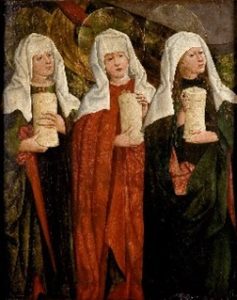
Charles Dickens in his novel of the French revolution, used the idea of the jacquerie as a means of confusing the authorities attempting to weed out culprits among the peasants. When asked someone’s name, the answer was always ‘Jacques’. Rowan Atkinson did a very silly skit about all motor mechanics being called Bob. What has this to do with women in the gospel accounts? Well, I have been a bit cynical but it always seems to me that when the men were writing about Jesus and it was needful to include some of the women to make the story faithful to events, when they didn’t know the names, they put in ‘Mary’, so there is a small assortment of women who all go by that name. It is, of course, possible that Mary was such a popular name it occurred with this frequency.
Women as individuals are scarce in the story so I thought, in this exploration of the ones we can identify, it would be appropriate to mention this collection of Marys, even though we have nothing to go on about their lives or situations at the time. We only hear of them as standing by the Cross but we are told that they had come with Him from Galilee. Clearly, throughout His ministry there were always women with Him. At the Cross are listed, by Mark, Mary the mother of James the younger and Joses and Salome. Matthew says Joseph rather than Joses and adds in the mother of the sons of Zebedee. The Gospel of John records His mother’s sister being there and Mary the wife of Cleopas. Luke only mentions that the women who followed him from Galilee were watching. That is all we have of these women. The two Marys about whom we know a little more are His particular friends, Mary Magdalene and Mary the sister of Martha and Lazarus.
There is one more piece about women encountering Jesus that I want to discuss and it comes from Luke. Luke’s Gospel has often been called ‘The Women’s Gospel’ and I take some exception to this! One particular piece quoted to support this view is Luke 8:2-3, which we have noticed in another context. There are not many texts in the New Testament that make me tut and none more than this.
Luke mentions the women who follow along with Jesus. He tells us, as a simple fact, that the blokes are there, but of the women he indicates that they are all rehabilitees, people Jesus has cured, including, as we saw, Mary Magdalene, “from whom seven demons had gone out.” I tut because this is one of the ways in which the emerging church begins to re-position women, after a brief time in which, in the company of Jesus, they were treated like real people. For once here was someone encountering them and actually seeing them. I am not, of course, suggesting that no-one had ever seen any individual woman in that way before, that would be absurd, but as we were seeing previously, collective opinion is a powerful means of managing the populace. Society deemed that there was a ‘right place’ for women. They were inferior to men, on account of the ‘natural superiority of the male’ which was divinely ordained (as C.S.Lewis was still claiming mid-twentieth century!) As Christianity was about establishing itself, spreading the Good News i.e. the Gospel, it would have seriously inhibited progress if one of its practical determinants was the equality of the sexes!
Luke’s Gospel has been known as ‘the women’s gospel’ because he mentions a significant number of women in his account of Jesus’ ministry. My point is that, while it is true, it is also true that his women tend to be needy, unhappy, dependent or sinful. Luke says that these women “provided for them out of their resources” which suggests the women he had in mind were not simple villagers but women of some standing.” their resources” would seem to indicate that they had financial means at their disposal and were of some consequence.
We will see in some articles to come his treatment of Mary Magdalene and the sisters, Martha and Mary, and how this works out in contrast to other gospel accounts of these particular friends. We also looked at the way Luke dismisses the women who bear the news of the Resurrection. According to him they were not believed and he indicates that it is not until Peter validates it that the disciples take notice. There is no narrative of Jesus speaking individually to Peter. It is hard not to see a purpose in this bias. It can read as though there is a decision to down-play the place of women in the Jesus story in the cause of promulgating the Gospel. But it might also be that some nascent communities were not happy with women behaving ’out of their station’. The history of the early church is just as littered with petty jealousy and conflict as the church has been at any time in its history. There is evidence for communities where women were in positions of authority being deemed heretical. When we come to consider the women of the Fourth Gospel, we will find a wholly different approach with a strong sense of the women being participants of equality.
